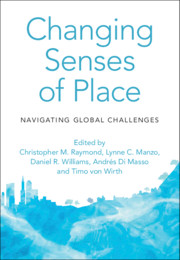Book contents
- Changing Senses of Place
- Changing Senses of Place
- Copyright page
- Dedication
- Contents
- Contributors
- Foreword
- Preface
- Acknowledgements
- Introduction
- Part I Climate Change and Ecological Regime Shifts
- 1 Coral Reef Collapse and Sense of Place in the Great Barrier Reef, Australia
- 2 Navigating the Temporalities of Place in Climate Adaptation
- 3 The Place–Subjectivity Continuum after a Disaster
- 4 Changing Sense of Place and Local Responses to Bengaluru’s Disappearing Lakes
- 5 Place-Making for Regional Conservation
- Part II Migration, Mobility and Belonging
- Part III Renewable Energy Transitions
- Part IV Nationalism and Competing Territorial Claims
- Part V Urban Change
- Part VI Technological and Legal Transformations
- Part VII Design and Planning Strategies for Changing Senses of Place
- Part VIII Conclusion
- Index
- References
3 - The Place–Subjectivity Continuum after a Disaster
Enquiring into the Production of Sense of Place as an Assemblage
from Part I - Climate Change and Ecological Regime Shifts
Published online by Cambridge University Press: 15 July 2021
- Changing Senses of Place
- Changing Senses of Place
- Copyright page
- Dedication
- Contents
- Contributors
- Foreword
- Preface
- Acknowledgements
- Introduction
- Part I Climate Change and Ecological Regime Shifts
- 1 Coral Reef Collapse and Sense of Place in the Great Barrier Reef, Australia
- 2 Navigating the Temporalities of Place in Climate Adaptation
- 3 The Place–Subjectivity Continuum after a Disaster
- 4 Changing Sense of Place and Local Responses to Bengaluru’s Disappearing Lakes
- 5 Place-Making for Regional Conservation
- Part II Migration, Mobility and Belonging
- Part III Renewable Energy Transitions
- Part IV Nationalism and Competing Territorial Claims
- Part V Urban Change
- Part VI Technological and Legal Transformations
- Part VII Design and Planning Strategies for Changing Senses of Place
- Part VIII Conclusion
- Index
- References
Summary
In this chapter, we propose a material–semiotic epistemological approach to understand the changing senses of place resulting from socio-environmental disasters. This perspective involves investigating the simultaneously symbolic, corporeal and geographical relations that characterise the production of new senses of place in post-disaster contexts. We propose the notion of assemblage as a conceptual tool to understand how senses of place are generated within a complex and dynamic network of influences and reciprocal variations between subjective, social and spatial aspects, articulating at the same time the relationship between individual experiences of place and social and institutional processes. To present, discuss and illustrate this material–semiotic approach, we draw on a part of the results of a study conducted in Chile, addressing multiple case studies of post-disaster situations.
Keywords
- Type
- Chapter
- Information
- Changing Senses of PlaceNavigating Global Challenges, pp. 43 - 52Publisher: Cambridge University PressPrint publication year: 2021
References
- 1
- Cited by



